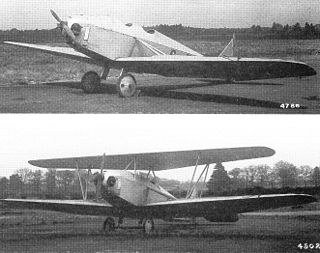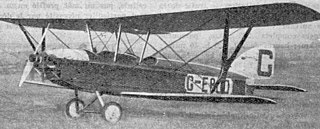Aircraft
- CLA.1 - The Cranwell CLA.1 was the first attempt by the Club to design an aircraft but was never built.
- CLA.2 - The Cranwell CLA.2 was a two-seat single-engined biplane designed and built for the 1924 Lympne light aircraft trials. [2] It was first flown at Cranwell at 14 September 1924 and went on to win the £300 Reliability Prize at Lympne. [2] After the light plane trials the CLA.2 went to RAF Martlesham Heath for evaluation but it was written off by an Air Ministry pilot. [2] The Air Ministry compensated the club for the loss and this was used to fund the next project.

The Cranwell CLA.2 was a single-engined two-seat biplane built by staff and students of RAF College Cranwell as an entrant to the Lympne Two Seater Light Aeroplane Trials of 1924. It won the reliability prize.
The Lympne Light Aircraft Trials were held to encourage the development of practical light aircraft for private ownership, with a strong but not exclusive emphasis on fuel economy. They were held in 1923, 1924 and 1926. Each year saw different restrictions on engine size, framed initially in terms of capacity and then weight. The Daily Mail newspaper provided cash prizes throughout though the initiating donation came from the Duke of Sutherland. The Air Ministry were prize givers in the 1924 event. The trials were held at Lympne in Kent, England.

Royal Air Force Station Martlesham Heath or more simply RAF Martlesham Heath is a former Royal Air Force station located 1.5 miles (2.4 km) south west of Woodbridge, Suffolk, England. It was active between 1917 and 1963, and played an important role in the development of Airborne Interception radar.
- CLA.3 - The Cranwell CLA.3 was designed to compete in the 1925 Lympne light aircraft trials, a high-wing braced monoplane powered by a Bristol Cherub engine. [2] It won the International Speed Race at Lympne when it achieved 86.92 mph. [2] The CLA.3 was scrapped in 1929. [2]

The Cranwell CLA.3 was a parasol winged single-engined, single-seat British aircraft built to compete in the Lympne air races of 1925. It was designed and built by an amateur group drawn from staff and pupils at the RAF College Cranwell. Though it won one prize and set a Class record, only one CLA.3 was made.

The Bristol Cherub is a British two-cylinder, air-cooled, aircraft engine designed and built by the Bristol Aeroplane Company. Introduced in 1923 it was a popular engine for ultralight and small aircraft in the 1930s.

- CLA.4 - Two Cranwell CLA.4s were built for the 1926 Lympne light aircraft trials, they were two-seat inverted sesquiplanes. [2] The first aircraft was flown by Comper at the trials but was withdrawn with a damaged landing gear. [2] The second aircraft was destroyed in a crash in March 1927. [2]

The Cranwell CLA.4 was a single-engined two-seat inverted sesquiplane designed and constructed for the 1926 Lympne trials by an amateur group from RAF College Cranwell. Two were entered, though engine problems prevented one from taking part; the other was eliminated with a broken undercarriage. A third aircraft was amateur-built in Canada and flew until 1934.
- CLA.7 - The Comper CLA.7 Swift was designed by Comper for the Club but was built after he left the Royal Air Force by his company Comper Aircraft Company. [3]

The Comper C.L.A.7 Swift is a British 1930s single-seat sporting aircraft produced by Comper Aircraft Company Ltd of Hooton Park, Cheshire.
The Comper Aircraft Company Ltd was a 1930s British light aircraft manufacturer. It was based at Hooton Aerodrome, Cheshire (1929-1933), and Heston Aerodrome, Middlesex (1933-1934).









